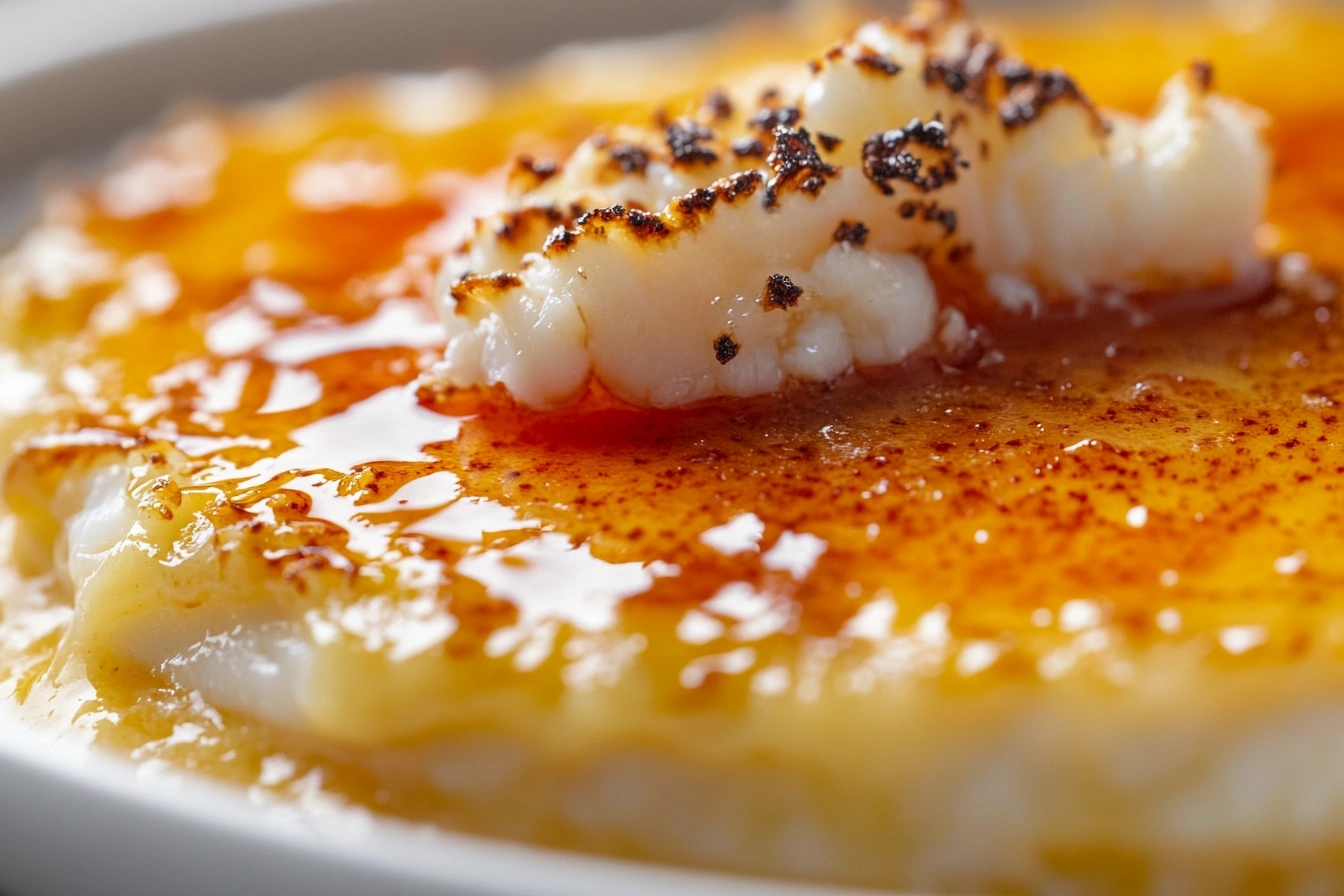Understanding Crab Brûlée & Preparation
1. Introduction to Crab Brûlée (200 Words)
Table of Contents
Crab brûlée is a unique fusion dish that combines the silky richness of crème brûlée with the delicate sweetness of fresh crab. This savory twist on a classic French dessert is gaining popularity in high-end restaurants and gourmet kitchens worldwide.
At its core, crab brûlée follows the custard-based structure of traditional crème brûlée but replaces sugar and vanilla with seafood, cheese, and aromatics. The dish is typically made with fresh crab meat, eggs, cream, and seasonings, resulting in a smooth, umami-rich custard. The final step involves caramelizing a sugar or cheese topping, creating a crispy, golden crust that contrasts beautifully with the soft interior.
This dish has become a gourmet delicacy due to its sophisticated flavor profile and luxurious presentation. It’s often served as an elegant appetizer at fine dining establishments, paired with toasted crostini or buttered brioche. The combination of creamy, savory custard and the delicate crunch of the brûléed topping makes it a standout dish for special occasions.
Whether you’re a professional chef or a home cook looking to impress, mastering crab brûlée is a rewarding culinary challenge that elevates seafood to a whole new level.
2. Key Ingredients for the Perfect Crab Brûlée (250 Words)
1. Fresh Crab Meat
- The best crab brûlée starts with high-quality crab meat. Popular choices include:
- King crab: Sweet and firm.
- Blue crab: Delicate and flaky.
- Lump crab meat: Mild and easy to use.
- Avoid canned or imitation crab, as fresh crab enhances the dish’s natural sweetness.
2. Cream and Eggs
- Heavy cream and egg yolks form the custard base, providing richness and structure.
- The ratio of cream to eggs affects texture—too much egg results in firmness, while too much cream makes it too soft.
3. Cheese
- Cheese adds depth and enhances the umami flavor. Popular choices include:
- Gruyère: Nutty and melty.
- Parmesan: Sharp and salty.
- Goat cheese: Creamy and tangy.
4. Seasonings & Aromatics
- Garlic & shallots – Add a savory depth.
- Dijon mustard – Brings mild heat and complexity.
- Chives & tarragon – Brighten the flavor.
5. Wine or Brandy
- A splash of white wine, sherry, or brandy adds complexity and balance.
6. Sugar for the Brûlée Topping
- White sugar creates a traditional caramelized crust.
- Brown sugar adds a deeper, molasses-like sweetness.
- Parmesan crust provides a savory, cheesy alternative.
These ingredients, when combined, create a luxurious dish that is rich, balanced, and indulgent.
3. How to Make Crab Brûlée: Step-by-Step Guide (400 Words)
Step 1: Preparing the Crab Meat
- Select the freshest crab meat possible, ensuring it’s free from shells and cartilage.
- Gently shred the crab meat with a fork, keeping some larger pieces for texture.
- If using whole crabs, steam them for 10–15 minutes, then remove the meat carefully.
- Lightly season the crab with a pinch of salt, avoiding overpowering the natural sweetness.
Step 2: Making the Custard Base
- In a saucepan, gently sauté minced shallots and garlic in butter until translucent.
- In a mixing bowl, whisk together:
- 4 egg yolks
- 1 cup heavy cream
- ¼ cup grated Gruyère or Parmesan
- ½ teaspoon Dijon mustard
- A splash of white wine or sherry
- Pinch of salt, black pepper, and cayenne (optional)
- Slowly incorporate the warm garlic-shallot mixture into the egg mixture, whisking constantly to prevent curdling.
- Gently fold in the crab meat, keeping some chunks whole for texture.
Step 3: Baking the Brûlée
- Preheat the oven to 300°F (150°C).
- Pour the custard into ramekins, filling them about ¾ full.
- Place the ramekins into a baking dish and pour hot water halfway up the sides (this water bath ensures even cooking).
- Bake for 25–30 minutes until the custard is just set but slightly jiggly in the center.
- Remove from the oven and let cool to room temperature before refrigerating for at least 1 hour.
Step 4: Caramelizing the Top
- Before serving, sprinkle 1 teaspoon of white sugar (or grated Parmesan for a savory version) evenly on top of each custard.
- Using a culinary torch:
- Hold the torch 6 inches away and move in a circular motion until a golden-brown crust forms.
- Using an oven broiler:
- Preheat the broiler to high.
- Place ramekins under the broiler for 1–2 minutes, watching closely to prevent burning.
Once caramelized, let the brûlée rest for 2 minutes, then serve immediately with toasted crostini or buttery brioche.
This step-by-step guide ensures a smooth, creamy custard with a perfectly crisp topping, creating a restaurant-quality crab brûlée at home. 🦀🔥

Variations, Serving & FAQs
4. Creative Variations of Crab Brûlée (250 Words)
While the classic crab brûlée is already a luxurious dish, there are several variations that introduce new flavors, textures, and culinary influences. Here are some gourmet twists to elevate the traditional recipe:
1. Classic Crab Brûlée
- The traditional version with a creamy custard base, mild spices, and a crisp brûléed top.
- Uses lump crab meat, Gruyère cheese, and a touch of Dijon mustard for balance.
2. Spicy Cajun Crab Brûlée
- Inspired by Southern Cajun flavors, this variation adds:
- Old Bay seasoning, cayenne pepper, and smoked paprika for heat.
- A dash of hot sauce to enhance the spice level.
3. Truffle Crab Brûlée
- A high-end version that incorporates:
- Truffle oil in the custard for an earthy, umami flavor.
- Shaved truffles as a garnish for extra decadence.
4. Asian-Inspired Crab Brûlée
- Infused with Japanese and Chinese flavors:
- White miso paste for depth.
- Soy sauce and grated ginger for an umami kick.
- Garnished with toasted sesame seeds.
5. Lobster & Crab Brûlée
- A surf-and-surf variation, combining two premium seafoods:
- 50/50 blend of crab and lobster meat.
- Lobster stock in the custard base for extra richness.
These creative variations allow you to customize crab brûlée to match your preferred taste profile and dining occasion.

5. Best Ways to Serve Crab Brûlée (200 Words)
Crab brûlée is a luxurious dish that deserves equally refined presentation. Here are the best ways to serve and pair it:
1. Garnishing Options
To enhance the visual appeal and flavor, garnish with:
- Fresh chives or microgreens – for a bright, herby contrast.
- Caviar or tobiko – adds a salty, briny pop of flavor.
- Crispy shallots – introduces a savory crunch.
2. Pairing with Sides
Crab brûlée is best served with mild, crispy accompaniments:
- Toasted crostini – for dipping.
- Buttered brioche – soft and slightly sweet to complement the custard.
- Savory crackers – a crunchy, neutral pairing.
3. Wine Pairings
Pair crab brûlée with elegant white wines that enhance its creaminess:
- Chardonnay – buttery and oaky, matching the richness.
- Champagne or Sparkling Wine – cuts through the custard’s heaviness with bright acidity.
- Sauvignon Blanc – crisp and citrusy, balancing the sweetness of the brûléed top.
Serving crab brûlée with carefully chosen garnishes, sides, and wine pairings ensures a memorable fine dining experience.
6. Expert Cooking Tips for the Perfect Crab Brûlée (200 Words)
Even with a great recipe, making the perfect crab brûlée requires attention to detail. Here are expert tips to ensure success:
1. Preventing Eggs from Scrambling in the Custard
- Temper the eggs properly: Gradually add warm cream to the egg mixture while whisking constantly.
- Use a low baking temperature (275°F–325°F) to avoid curdling.
- Bake in a water bath to ensure gentle, even heat distribution.
2. Achieving the Right Balance of Sweetness & Savoriness
- Do not over-salt the custard; let the natural sweetness of crab shine.
- If using a sugar brûlée topping, balance it with a pinch of sea salt.
- Try a Parmesan crust instead of sugar for a fully savory brûlée.
3. Best Way to Torch the Sugar Without Burning
- Hold the culinary torch 6 inches away and move in small circles.
- Use white sugar for an even crust; brown sugar caramelizes faster but can burn easily.
- If using the oven broiler, keep a close eye to prevent over-caramelization.
By following these pro tips, you can create a perfectly smooth, flavorful, and beautifully brûléed crab dish every time.
7. Frequently Asked Questions (FAQs) (300 Words)
1. Can I make crab brûlée ahead of time?
Yes! Prepare the brûlée custard in advance, refrigerate it after baking, and torch the sugar topping just before serving to maintain its crisp texture.
2. Can I use canned crab instead of fresh crab?
Fresh crab is always preferred for best flavor and texture, but high-quality canned lump crab can be used as a substitute. Drain it well to avoid excess moisture.
3. What sugar is best for the brûlée topping?
- White sugar creates an even, crisp crust.
- Brown sugar provides deeper caramel notes but can burn faster.
- Parmesan cheese can be used instead of sugar for a savory topping.
4. Is crab brûlée served hot or cold?
Traditionally, crab brûlée is served warm, but some chefs serve it chilled with a brûléed top for a unique contrast in textures.
5. Can I substitute crab with another seafood?
Absolutely! Great alternatives include:
- Lobster brûlée – Luxurious and sweet.
- Shrimp brûlée – More affordable but equally delicious.
- Scallop brûlée – A softer, delicate variation.
Crab brûlée is a versatile dish, and these substitutions allow for creative variations while maintaining its gourmet appeal.
Conclusion
Crab brûlée is a stunning fusion of savory seafood and classic French custard, making it a show-stopping dish for special occasions. Whether you stick to the classic recipe or explore creative variations, this dish is sure to impress food lovers and fine dining enthusiasts alike.
By mastering the cooking techniques, serving suggestions, and expert tips, you can create a luxurious seafood dish that elevates crab to new heights. Whether served as an appetizer, main course, or gourmet snack, crab brûlée is a true delicacy worth trying.
Would you like additional pairing recommendations or plating ideas to further enhance your dish? Let me know! 🍽️🦀🔥

